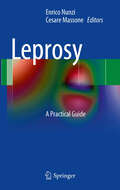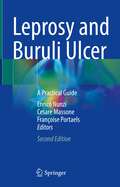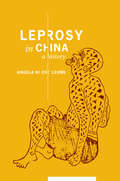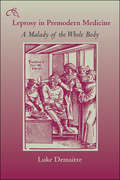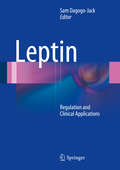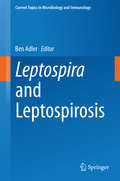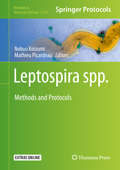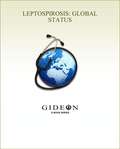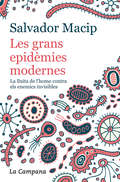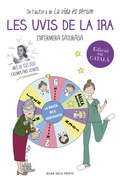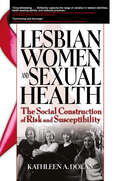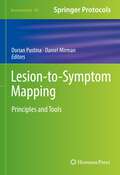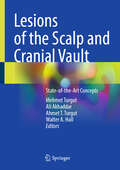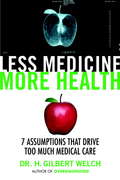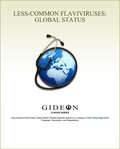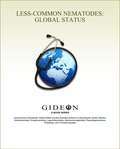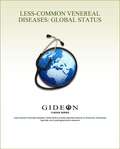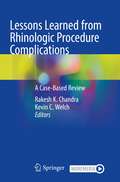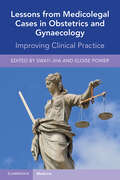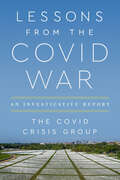- Table View
- List View
Leong's Manual of Diagnostic Antibodies for Immunohistology
by Runjan Chetty Kumarasen Cooper Gown Allen M.Providing a unique A-Z guide to antibodies for immunohistology, this is an indispensable source for pathologists to ensure the correct application of immunohistochemistry in daily practice. Each entry includes commercial sources, clones, descriptions of stained proteins/epitopes, the full staining spectrum of normal and tumor tissues, staining pattern and cellular localization, the range of conditions of immunoreactivity, and pitfalls of the antibody's immunoprofile, giving pathologists a truly thorough quick-reference guide to sources, preparation and applications of specific antibodies. Appendices provide useful quick-reference tables of antibody panels for differential diagnoses, as well as summaries of diagnostic applications. Expanded from previous editions with over forty new entries, this handbook for diagnostic, therapeutic, prognostic and research applications of antibodies is an essential desktop book for practicing pathologists as well as researchers, residents and trainees.
Leprosy
by Cesare Massone Enrico NunziLeprosy (Hansen's disease) is an infectious disease caused by Mycobacterium leprae. It is one of the most disabling disorders in developing countries, with a peak incidence in the tropics and subtropics. With globalization, leprosy is now increasingly spreading to the western world. The impact of this infectious disorder is relevant for the human community due to its transmissible nature, and also important for the individual because of its debilitating consequences. Leprosy is a multifaceted systemic disease with variable presentation and clinical picture. Its identification may therefore not be straightforward, especially outside endemic areas. During its chronic course, leprosy is characterized by acute phases during which there may be exacerbation of symptoms and rapid progression of damage. When leprosy affects the eyes, nerves, and kidneys, it can represent a true medical emergency. The aim of this book is to make the reader familiar with the characteristic signs of disease, including abnormalities of the skin, nerves, eyes, hands, feet, testes, and bone. Early identification of the disease is critical to prevent patient disability and establish appropriate therapy. Emphasis will be given to the current diagnostic tools to identify and quantify the organ damage, including electrophysiology, ultrasonography, magnetic resonance imaging, laboratory tests, and histopathology. Specific topics such as leprosy and pregnancy, leprosy and HIV infection, epidemiology, and leprosy control will also be covered.
Leprosy and Buruli Ulcer: A Practical Guide
by Cesare Massone Enrico Nunzi Françoise PortaelsA highly disabling infectious disease in developing countries, leprosy, or Hansen’s disease, is caused by Mycobacterium leprae, and is still very relevant for the human community due to its transmissible nature, variable presentation and composite clinical picture. Early identification of leprosy and Buruli ulcer (also caused by a Mycobacterium, M. ulcerans) is critical to prevent spreading and patient disability and to establish appropriate therapy. This richly illustrated, completely revised second edition of Leprosy and Buruli Ulcer describes the characteristic signs of both these diseases, and contents include abnormalities of the skin, nerves, eyes, hands, feet, testes and bone. It also presents the latest diagnostic tools to identify and quantify organ damage to enable readers to recognize and treat this composite systemic disorder, which can represent a true medical emergency if affecting eyes, nerves, and kidneys. Further, it includes additional chapters on leprosy in childhood, prophylaxis and vaccines. For both leprosy and Buruli ulcer, this handy guide helps practitioners and nursing personnel to spot the different clinical manifestations, make a prompt diagnosis and apply effective treatment of both these diseases.
Leprosy in China: A History (Studies of the Weatherhead East Asian Institute, Columbia University)
by Angela Ki LeungAngela Ki Che Leung's meticulous study begins with the classical annals of the imperial era, which contain the first descriptions of a feared and stigmatized disorder modern researchers now identify as leprosy. She then tracks the relationship between the disease and China's social and political spheres (theories of contagion prompted community and statewide efforts at segregation); religious traditions (Buddhism and Daoism ascribed redemptive meaning to those suffering from the disease), and evolving medical discourse (Chinese doctors have contested the disease's etiology for centuries). Leprosy even pops up in Chinese folklore, attributing the spread of the contagion to contact with immoral women.Leung next places the history of leprosy into a global context of colonialism, racial politics, and "imperial danger." A perceived global pandemic in the late nineteenth century seemed to confirm Westerners' fears that Chinese immigration threatened public health. Therefore battling to contain, if not eliminate, the disease became a central mission of the modernizing, state-building projects of the late Qing empire, the nationalist government of the first half of the twentieth century, and the People's Republic of China. Stamping out the curse of leprosy was the first step toward achieving "hygienic modernity" and erasing the cultural and economic backwardness associated with the disease. Leung's final move connects China's experience with leprosy to a larger history of public health and biomedical regimes of power, exploring the cultural and political implications of China's Sino-Western approach to the disease.
Leprosy in Premodern Medicine: A Malady of the Whole Body
by Luke DemaitreWhile premodern poets and preachers viewed leprosy as a "disease of the soul," physicians in the period understood it to be a "cancer of the whole body." In this innovative study, medical historian Luke Demaitre explores medical and social perspectives on leprosy at a time when judicious diagnosis could spare healthy people from social ostracization and help the afflicted get a license to beg.Extending his inquiry from the first century to late in the eighteenth century, Demaitre draws on translations of academic treatises and archival records to illuminate the professional standing, knowledge, and conduct of the practitioners who struggled to move popular perceptions of leprosy beyond loathing and pity. He finds that, while not immune to social and cultural perceptions of the leprous as degenerate, and while influenced by their own fears of contagion, premodern physicians moderated society's reactions to leprosy and were dedicated to the well-being of their patients.
Leptin
by Sam Dagogo-JackTwenty years after its discovery, recombinant human leptin has been approved by the Food and Drug Administration for the treatment of patients with lipodystrophy. Beginning with a synthesis of the vast body of work on its discovery, dissection of mechanisms, and effects in experimental models , the focus of this book shifts to a consideration of the regulation and role of leptin in humans. The emphasis on human-level data is a unique feature of this book. The results of numerous studies indicate that leptin is indeed a regulated human hormone. Leptin provides a detailed account of the myriad physiological, hormonal, metabolic, immunological, mitogenic and inflammatory modulators and targets of leptin in a single volume. Next follows a comprehensive presentation of the therapeutic trials of recombinant leptin in patients with congenital leptin deficiency, lipodystrophy, hypothalamic amenorrhea, and other emerging areas, including leptin supplementation in leptin-replete subjects, leptin substitution for insulin in diabetic models, and novel combination regimens of leptin and other biogenic peptides. Unanswered questions and future directions in leptin research are highlighted in the Foreword by Dr. Jeffrey Friedman and throughout the volume. Identifying such questions helps direct research that could deepen understanding of the complex regulation of leptin under physiological and pathological conditions, a critical prerequisite to its rational deployment in the treatment of human disorders.
Leptospira and Leptospirosis
by Ben AdlerThis volume covers all aspects of infection by pathogenic Leptospira species, the causative agents of the world's most widespread zoonosis. Topics include aspects of human and animal leptospirosis as well as detailed analyses of our current knowledge of leptospiral structure and physiology, epidemiology, pathogenesis, genomics, immunity and vaccines. Updates are presented on leptospiral systematics, identification and diagnostics, as well as practical information on culture of Leptospira. Contact information is also provided for Leptospira reference centers. All chapters were written by experts in the field, providing an invaluable reference source for scientists, veterinarians, clinicians and all others with an interest in leptospirosis.
Leptospira spp.: Methods and Protocols (Methods in Molecular Biology #2134)
by Nobuo Koizumi Mathieu PicardeauThis volume looks at all aspects of manipulation of Leptospira spp. from strain isolation to the latest techniques used to study the pathogenesis of leptospirosis. The chapters in this book cover topics such as the procedure to cultivate and isolate leptospires from both clinical and environmental samples; using methods like whole genome sequencing and Matrix Assisted Laser Desorption/Ionization Time of Flight Mass Spectrometry to identify bacterial species; tools for gene inactivation and in vitro and in vivo assays to study the pathogenesis of leptospirosis; and the use of hamsters to evaluate leptospiral virulence and vaccine candidates. Written in the highly successful Methods in Molecular Biology series format, chapters include introductions to their respective topics, lists of the necessary materials and reagents, step-by-step, readily reproducible laboratory protocols, and tips on troubleshooting and avoiding known pitfalls.Cutting-edge and comprehensive, Leptospira spp.: Methods and Protocols is a valuable resource for researchers interested in learning more about this developing field and these fascinating organisms.
Leptospirosis: Global Status 2010 edition
by Dr Stephen Berger Gideon InformaticsLeptospirosis: Global Status is one in a series of GIDEON ebooks which summarize the status of individual infectious diseases, in every country of the world. Data are based on the GIDEON database (www.gideononline.com) which relies on standard text books, peer-review journals, Health Ministry reports and ProMED, supplemented by an ongoing search of the medical literature. Chapters are arranged alphabetically, by country name. Each section is divided into five subsections. 1. Descriptive epidemiology 2. Summary of clinical features 3. Global status of the disease 4. Status of the disease in a specific country 5. References
Les grans epidèmies modernes (edició actualitzada): La lluita de l'home contra els enemic invisibles
by Salvador Macip¿Podrem vèncer el coronavirus? La guia bàsica per entendre els virus i les pandèmies. Si podrem vèncer el coronavirus és una pregunta que ens afecta a tots, perquè les malalties infeccioses són un problema global. Comencen en un racó del planeta, però el nostre estil de vida fa que s'estenguin ràpidament. Per això les pandèmies continuaran sent freqüents, i sense la cooperació de la gent no podrem fer front a les infeccions amb garanties d'èxit. El primer que hem d'aconseguir és que els microbis deixin de ser uns grans desconeguts. Aquest llibre ens permetrà entendre millor què vol dir compartir el planeta amb tots aquests enemics invisibles i ens ajudarà a trobar plegats el punt d'equilibri entre l'alarma i la prudència que ens permeti sobreviure com a espècie molts mil·lennis més. Salvador Macip té un prestigiós historial com a investigador a la Gran Bretanya i als Estats Units, i no només té grans coneixements, sinó que a més sap explicar-los. El tema és apassionant. I vital, per tot el que hi ha en joc.
Les plantes médicinales: La santé grâce à la force de la nature
by Dr Angela FetznerLa phytothérapie – la plus ancienne forme thérapeutique au monde Les remèdes naturels, en particulier les plantes médicinales, furent longtemps le seul réservoir de médicaments des médecins et des pharmaciens. Les plantes médicinales servaient en outre de matière première importante dans la fabrication des médicaments. Identifier, cueillir et faire sécher les plantes médicinales (Le livre contient également des photos en couleur des plantes) On trouve les plantes médicinales partout dans la nature – dans les prairies, dans la forêt, au bord du chemin. Ce livre explique tout sur la façon de cueillir les plantes médicinales et quelles parties de la plante – fleurs, feuilles, fruits, racines et écorce – sont utilisées. Préparations à base d’herbes – les plantes médicinales peuvent servir à de multiples usages La forme d’utilisation la plus simple des herbes médicinales est la tisane. Il existe cependant bien plus de possibilités d’utilisation des plantes médicinales – les préparations connues à base de plantes médicinales sont par exemple les teintures, les pommades, les crèmes ainsi que l’utilisation sous forme de bains. Ce livre fournit un aperçu de la préparation et de l’utilisation des différentes formes de médicament. Le mode d’action et l’utilisation des plantes médicinales les plus importantes sont exposés en détail Ce guide décrit en détail les plantes médicinales les plus connues et les plus importantes. Il explique pour quelles maladies les différentes plantes agissent, tout en livrant des informations captivantes sur les coutumes anciennes, les utilisations oubliées et des données scientifiques. Formules – Pommades, bains, huiles, confitures, etc. De nombreuses recettes donnent des idées et des suggestions pour la confection de pommades, de bains, pour la cuisine ainsi que pour des soins de santé et de beau
Les traitements naturels contre l’impuissance (Dr. Angela Fetzner #3)
by Dr Angela FetznerComme vous le découvrirez dans ce guide, il n'est pas toujours nécessaire de prendre les pilules bleues... Il existe de nombreux traitements de l’impuissance à base de plantes doux mais sûrs. De nombreux traitements contre l’impuissance à base de plantes sont connus depuis longtemps dans les pays d'origine souvent lointains et leur effet de renforcement de la puissance y est utilisé depuis des siècles ; mais ce n'est que progressivement que ces stimulants sexuels à base de plantes conquièrent le marché européen. Derrière le désir en faveur des stimulants sexuels à base de plantes se cache bien sûr aussi le désir de ne pas avoir à « s’épuiser » lors de l'acte sexuel avec une pilule chimique, car au fond de nous, nous tendons vers le désir d’une sexualité holistique mystérieuse, unique et mystique. Et c'est exactement là que les plantes d’amour peuvent entrer en jeu : Non seulement elles renforcent la puissance, mais elles éveillent tous les sens et peuvent aider à réduire le stress et à se détendre correctement. Si nous la prenons à cœur, notre vie amoureuse (re)devient épanouissante et énigmatique.
Les uvis de la ira
by Enfermera SaturadaDesprés de La vida és sèrum i El tiempo entre suturas, i després d'haver recorregut mitja Espanya infructuosament fent turisme d'oposició cercant la plaça fixa, l'Infermera Saturada, «Satu» pels amics, torna a la càrrega més saturada i més llançada que mai amb Les uvis de la ira. COMPOSICIÓPrincipi actiu (75 %): Humor sanitari.Excipients (25 %): Ironia, humor negre, algun tuit i moltes segones intencions. POSOLOGIAAls adults no sanitaris, administrar un capítol cada 8 hores. Si pertany al gremi, administrar lliurement. INDICACIONSCapítols d'humor sanitari per a infermeres saturades, estudiants, supervisores, dones que criden de la borsa de treball, sanitaris en general i pacients en particular. CONTRAINDICACIONSNo se'n recomana l'administració a ministres de Sanitat. PRECAUCIONSAplicar amb compte a consellers de Sanitat i caps d'Infermeria. EFECTES SECUNDARISExplosions descontrolades de riure, pèrdues lleus d'orina, desig irrefrenable d'estudiar infermeria i addicció al món de la Enfermera Saturada. INTOXICACIÓEn cas de sobredosificació, no trucar al Centre Nacional de Toxicologia. PRESENTACIÓ100% digital. Tinta electrònica no comestible. ADVERTÈNCIESMantenir fora de l'abast de les infermeres tristes. Laboratoris Infermera Saturada®. Mirant el dolor amb un somriure des del 2012. Troba a la Infermera Saturada a:Facebook: EnfermeraSaturadaTwitter: @EnfrmraSaturadaInstagram: Enfermera_SaturadaWeb: enfermerasaturada.es
Lesbian S/M Safety Manual
by Pat CalifiaThis is a book written for lesbians by lesbians about how to practice S/M in a safe way. This includes emotional as well as physical safety.
Lesbian Studies: Setting An Agenda
by Tamsin WiltonNeither women's studies nor lesbian and gay studies offers an adequate theoretical or political base for lesbian scholarship. Lesbian Studies: Setting and Agenda aim to promote lesbian studies as an academic and political approach to both gender and the erotic, and to clarify the damaging influence of heterosexism across a range of disciplines. Drawing on feminism and queer theory, Tamsin Wilton argues that `lesbian' is a theoretical position which must be widely available in order to challenge the dominance of the heterosexual perspective. Engaging with theoretical and political debates, the book moves beyond its role of setting an agenda for lesbian studies into a wider role as resource and catalysts for anyone interested in gender and the erotic.
Lesbian Women and Sexual Health: The Social Construction of Risk and Susceptibility
by R Dennis Shelby Kathleen DolanInterviewer: Where did you find out how to have safe lesbian sex?Val: I found out in jail.Why do so many lesbian women engage in sexual behavior that puts their health, even their lives, at risk? Many know they&’re at risk, yet somehow feel safe enough to behave as if there is no reason to practice safe sex. Lesbian Women and Sexual Health: The Social Construction of Risk and Susceptibility examines how lesbian women perceive their level of risk for HIV and other sexually transmitted infections (STIs). It describes how their perceptions of risk and susceptibility are shaped by factors such as sexual identity, cultural themes, and community knowledge-and how those perceptions impact on the very real HIV/STI risks that lesbian women face. The genesis of Lesbian Women and Sexual Health: The Social Construction of Risk and Susceptibility lies in Kathleen Dolan&’s exploratory study of this under-researched area, in which 162 structured interviews and 70 in-depth interviews were conducted with women who self-identify as lesbians. What these women have to say will inform, educate, and probably surprise you. Tables and figures make complex data easy to access and understand.Lesbian women construct and label their identities and actions in complex ways that may lead to risky behavior. In the words of the women surveyed-and in Dr. Dolan&’s insightful commentary-this book explores the ways in which lesbian women construct their perceptions of risk and susceptibility to seek answers to questions that include: Do many lesbian women see themselves, to an extent, as immune to HIV contraction? How does their self-constructed sense of risk and susceptibility lead to making dangerous choices? Why, in spite of their professed willingness to engage in protective actions, do many lesbians not actually do so? Why do many lesbian women, and some of the health care professionals who serve them, feel that pap smears are not necessary for women who have sex only with other women-and what are the consequences of this opinion? What is the relationship between drug/alcohol use and risky sexual behaviors in lesbian women?Lesbian Women and Sexual Health: The Social Construction of Risk and Susceptibility is an important resource for women&’s/lesbian health advocates, health care professionals, and courses in gay/women&’s/medical studies. It addresses gaps in the existing research to enhance our understanding of the physical and mental health status of lesbian women, of risk factors and protective actions regarding HIV and STIs, and of the conditions for which protective actions actually reduce risk. Use it to update your knowledge of this under-studied area at the intersection of physical, emotional, and sexual health.
Lesion-to-Symptom Mapping: Principles and Tools (Neuromethods #180)
by Daniel Mirman Dorian PustinaRecent developments in lesion-symptom mapping (LSM) have spurred rapid growth. This volume provides comprehensive coverage of the steps and considerations involved in LSM. The chapters cover the definition and types of brain lesions, how to prepare them for analysis, standard LSM methods, network-based LSM methods, and approaches of transient lesions induced by brain stimulation. These chapters are supplemented by practical, hands-on mini tutorials on implementing the different analyses using freely-available software. In the Neuromethods series style, chapters include the kind of detail and key advice from the specialists needed to get started using LSM in your laboratory. Cutting-edge and thorough, Lesion-to-Symptom Mapping: Principles and Tools connects core conceptual issues with available tools, making it a valuable resource for experienced and new researchers.
Lesions of the Scalp and Cranial Vault: State-of-the-Art Concepts
by Walter A. Hall Mehmet Turgut Ali Akhaddar Ahmet T. TurgutWritten and edited by leading international authorities in the field, this book provides an in-depth review of the knowledge of the lesions of the scalp and cranial vault, with emphasis on their accurate diagnosis and the medical and often multidisciplined surgical approach to treating these disease processes. It includes chapters, organized into six main groups: first, general characteristics of lesions of the scalp and calvarium, including definitions, classifications, history, anatomy and histology, regeneration, clinical and imaging features; secondly, congenital and anatomic variants of the scalp and calvarium, including craniosynostosis and craniopagus conjoined twins; thirdly, benign disorders of the scalp and calvarium, including benign lesions with and without atrophy and neoplasms, scarring and pressure sores, and metabolic disorders; fourthly, traumatic, vascular and infectious lesions of the scalp and calvarium, including iatrogenic lesions, infectious or inflammatory, and vascular lesions and malformations; fifthly, malignant neoplasms and secondary malignancies of the scalp and calvarium, including hematologic and intracranial neoplasms; and sixthly, treatment and outcome for lesions of the scalp and calvarium, including nonsurgical treatment, principles of surgery, postoperative complications, prognosis as well as the medicolegal aspects related to these lesions. The uniqueness of this compilation lies in the fact that all aspects of these disease entities are compiled into one singular definitive work. All these issues are adequately addressed with clinical illustrations and examples. This comprehensive reference book is an ideal source for neuroscientists at all levels, from graduate students to researchers in specific disciplines studying this region including neurosurgeons, neurologists, pediatricians, plastic and reconstructive surgeons, neuroradiologists, neuropathologists, dermatologists, and neuroscientists in developmental neuroscience who seek both basic and more advanced information regarding the lesions of the scalp and cranial vault.
Less Medicine, More Health
by H. Gilbert WelchThe author of the highly acclaimed Overdiagnosed describes seven widespread assumptions that encourage excessive, often ineffective, and sometimes harmful medical care. You might think the biggest problem in medical care is that it costs too much. Or that health insurance is too expensive, too uneven, too complicated--and gives you too many forms to fill out. But the central problem is that too much medical care has too little value. Dr. H. Gilbert Welch is worried about too much medical care. It's not to deny that some people get too little medical care, rather that the conventional concern about "too little" needs to be balanced with a concern about "too much": too many people being made to worry about diseases they don't have--and are at only average risk to get; too many people being tested and exposed to the harmful effects of the testing process; too many people being subjected to treatments they don't need--or can't benefit from. The American public has been sold the idea that seeking medical care is one of the most important steps to maintain wellness. Surprisingly, medical care is not, in fact, well correlated with good health. So more medicine does not equal more health; in reality the opposite may be true. The general public harbors assumptions about medical care that encourage overuse, assumptions like it's always better to fix the problem, sooner (or newer) is always better, or it never hurts to get more information. Less Medicine, More Health pushes against established wisdom and suggests that medical care can be too aggressive. Drawing on his twenty-five years of medical practice and research, Dr. Welch notes that while economics and lawyers contribute to the excesses of American medicine, the problem is essentially created when the general public clings to these powerful assumptions about the value of tests and treatments--a number of which are just plain wrong. By telling fascinating (and occasionally amusing) stories backed by reliable data, Dr. Welch challenges patients and the health-care establishment to rethink some very fundamental practices. His provocative prescriptions hold the potential to save money and, more important, improve health outcomes for us all.From the Hardcover edition.
Less-Common Flaviviruses: Global Status 2010 edition
by Dr Stephen Berger Gideon InformaticsLess-Common Flaviviruses: Global Status is one in a series of GIDEON ebooks which summarize the status of individual infectious diseases, in every country of the world. Data are based on the GIDEON database (www.gideononline.com) which relies on standard text books, peer-review journals, Health Ministry reports and ProMED, supplemented by an ongoing search of the medical literature. Chapters are arranged alphabetically, by country name. Each section is divided into five subsections. 1. Descriptive epidemiology 2. Summary of clinical features 3. Global status of the disease 4. Status of the disease in a specific country 5. References Less-Common Flaviviruses: Global Status includes separate sections on Louping ill, Omsk hemorrhagic fever, Powassan, Spondweni, and Wesselsbron.
Less-Common Nematodes: Global Status 2010 edition
by Dr Stephen Berger Gideon InformaticsLess-Common Nematodes: Global Status is one in a series of GIDEON ebooks which summarize the status of individual infectious diseases, in every country of the world. Data are based on the GIDEON database (www.gideononline.com) which relies on standard text books, peer-review journals, Health Ministry reports and ProMED, supplemented by an ongoing search of the medical literature. Chapters are arranged alphabetically, by country name. Each section is divided into five subsections. 1. Descriptive epidemiology 2. Summary of clinical features 3. Global status of the disease 4. Status of the disease in a specific country 5. References Less-Common Nematodes: Global Status includes separate sections on Dioctophyme renalis infection, Gnathostomiasis, Gongylonemiasis, Lagochilascariasis, Mammomonogamiasis, Oesophagostomiasis, Thelaziasis, and Trichostrongyliasis.
Less-Common Venereal Diseases: Global Status 2010 edition
by Dr Stephen Berger Gideon InformaticsLess-Common Venereal Diseases: Global Status is one in a series of GIDEON ebooks which summarize the status of individual infectious diseases, in every country of the world. Data are based on the GIDEON database (www.gideononline.com) which relies on standard text books, peer-review journals, Health Ministry reports and ProMED, supplemented by an ongoing search of the medical literature. Chapters are arranged alphabetically, by country name. Each section is divided into five subsections. 1. Descriptive epidemiology 2. Summary of clinical features 3. Global status of the disease 4. Status of the disease in a specific country 5. References Less-Common Venereal Diseases: Global Status includes separate sections on Chancroid, Granuloma inguinale, and Lymphogranuloma venereum.
Lessons Learned from Rhinologic Procedure Complications: A Case-Based Review
by Rakesh K. Chandra Kevin C. WelchDespite meticulous attention to details and expert technique, complications resulting from rhinologic procedures can occur during one's professional career. This book discusses real-life complications and why these unfortunate events occur, as well as how best to manage the consequent issues. The text also provides thoughtful strategies to prevent such situations going forward. The book is organized as a series of case-based chapters, each illustrating a complication involving the orbit, the skull base, unexpected bleeding, poor healing, or those relating to intraoperative decision making, and how each was managed by the authors. Each chapter begins with bullet points highlighting key clinical pearls illustrated by that particular case. Written by leaders in the field with decades of experience in sino-nasal procedures, the analysis complements expert opinions with evidence-based published literature and shares experiences related to the most current techniques, devices, and instrumentation. Every otolaryngologist practicing rhinologic procedures will appreciate the candid nature of the discussion and will find enrichment in this shared wisdom. Lessons Learned from Rhinologic Procedure Complications: A Case-Based Review serves practitioners of general otolaryngology as well as resident trainees in this field, explaining how best to identify, diagnose, and resolve a complication during rhinology procedures.
Lessons from Medicolegal Cases in Obstetrics and Gynaecology: Improving Clinical Practice
by Swati Jha Eloise PowerObstetrics and gynaecology is the biggest area of medical litigation, with compensation pay-outs exceeding the rest of medicine combined. Many specialists working in the field will be sued over their professional lifetime - having an increased awareness of past cases and their implications will reduce the risk of future litigation. Using landmark cases in the field, this book covers scenarios such as multiple pregnancy, hysterectomy and breech delivery, describing factors that have led to litigation. Chapters are structured clearly, beginning with case commentaries detailing both a successful and unsuccessful claim. This section is followed by legal commentary explaining the relevant laws and the verdict, finally giving a clinical commentary provided by experts in the field which focuses on best practice to avoid litigation. Edited by an accredited expert witness in the field and a barrister specialising in medical law, this is an invaluable resource for clinicians and lawyers alike.
Lessons from the Covid War: An Investigative Report
by Covid Crisis GroupThis powerful report on what went wrong—and right—with America&’s Covid response, from a team of 34 experts, shows how Americans faced the worst peacetime catastrophe of modern times Our national leaders have drifted into treating the pandemic as though it were an unavoidable natural catastrophe, repeating a depressing cycle of panic followed by neglect. So a remarkable group of practitioners and scholars from many backgrounds came together determined to discover and learn lessons from this latest world war. Lessons from the Covid War is plain-spoken and clear sighted. It cuts through the enormous jumble of information to make some sense of it all and answer: What just happened to us, and why? And crucially, how, next time, could we do better? Because there will be a next time. The Covid war showed Americans that their wondrous scientific knowledge had run far ahead of their organized ability to apply it in practice. Improvising to fight this war, many Americans displayed ingenuity and dedication. But they struggled with systems that made success difficult and failure easy. This book shows how Americans can come together, learn hard truths, build on what worked, and prepare for global emergencies to come. A joint effort from: Danielle Allen • John M. Barry • John Bridgeland • Michael Callahan • Nicholas A. Christakis • Doug Criscitello • Charity Dean • Victor Dzau • Gary Edson • Ezekiel Emanuel • Ruth Faden • Baruch Fischhoff • Margaret &“Peggy&” Hamburg • Melissa Harvey • Richard Hatchett • David Heymann • Kendall Hoyt • Andrew Kilianski • James Lawler • Alexander J. Lazar • James Le Duc • Marc Lipsitch • Anup Malani • Monique K. Mansoura • Mark McClellan • Carter Mecher • Michael Osterholm • David A. Relman • Robert Rodriguez • Carl Schramm • Emily Silverman • Kristin Urquiza • Rajeev Venkayya • Philip Zelikow

